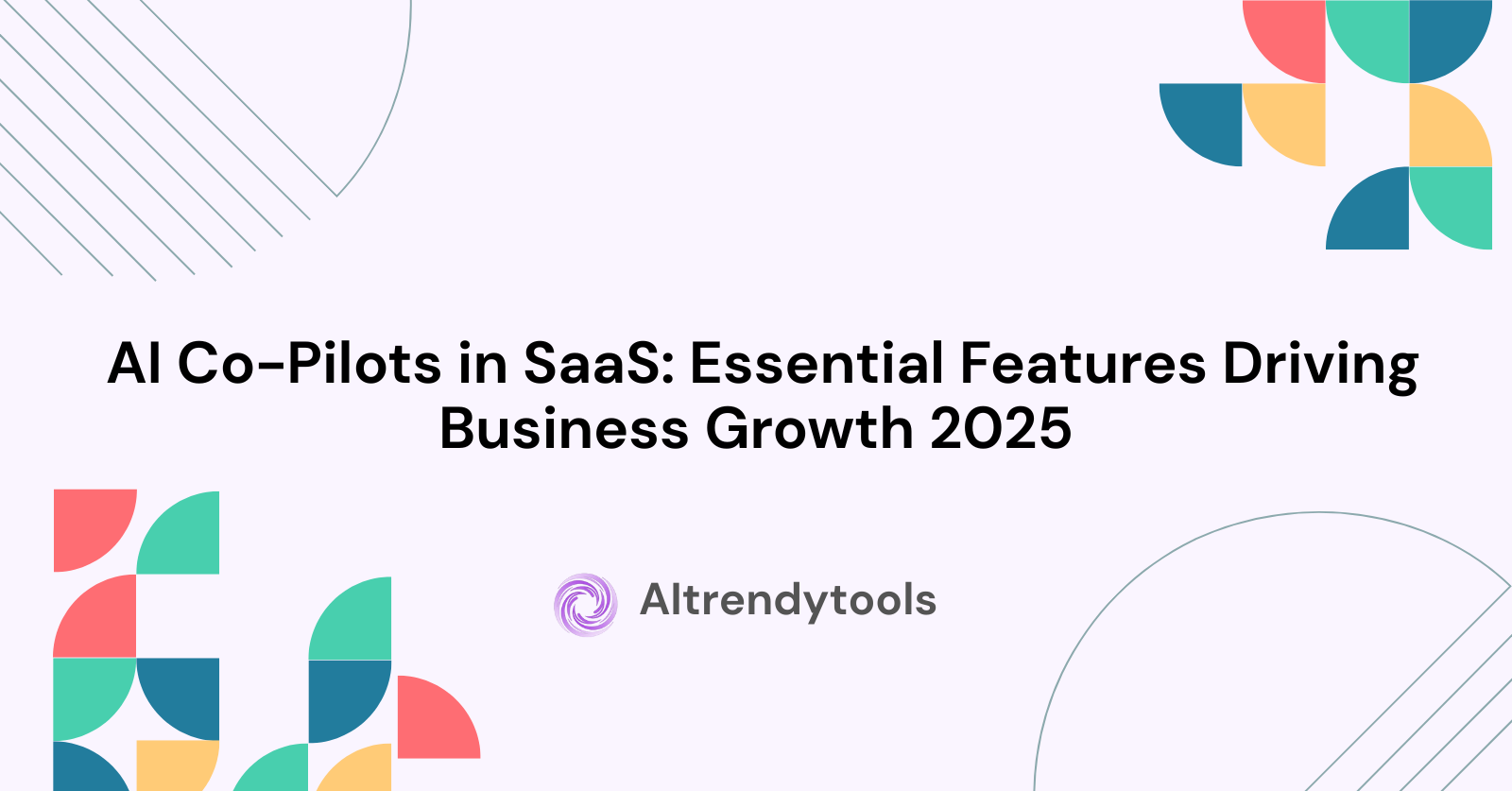🔥 AITrendytools: The Fastest-Growing AI Platform |
Write for usAI Co-Pilots in SaaS: Essential Features Driving Business Growth 2025
Discover why AI co-pilots are transforming SaaS platforms. Learn key benefits, implementation strategies, and real-world examples driving productivity.
Oct 3, 2025
Understanding AI Co-Pilot Technology in Modern SaaS
AI co-pilots represent a fundamental shift in how Software-as-a-Service platforms interact with users. These intelligent assistants go beyond traditional chatbots to provide proactive guidance, automate complex workflows, and deliver personalized experiences tailored to individual user needs.
The technology combines natural language processing, machine learning algorithms, and predictive analytics to create virtual assistants that understand context and anticipate user requirements. AI co-pilots learn from user behavior patterns and adapt their responses to provide increasingly relevant suggestions and support.
Modern SaaS businesses face increasing complexity as they scale operations and serve diverse customer segments. AI co-pilots address this challenge by simplifying user interactions while maintaining the sophisticated functionality that enterprise customers demand.
What Makes AI Co-Pilots Different from Traditional Automation
Traditional automation follows predetermined rules and responds to specific triggers. AI co-pilots use advanced algorithms to analyze patterns, predict outcomes, and make intelligent decisions based on contextual information.
Key Distinguishing Features:
- Dynamic learning from user interactions
- Contextual awareness of user goals and preferences
- Natural language communication capabilities
- Proactive assistance before problems arise
- Adaptive responses based on real-time data
These capabilities enable AI co-pilots to handle complex scenarios that would overwhelm traditional automation systems.
SaaS Platform Intelligence Revolution
SaaS platforms incorporating AI co-pilots experience transformation across multiple operational dimensions. These intelligent systems enhance user experience, streamline workflows, and provide data-driven insights that drive business growth.
The integration of AI co-pilots fundamentally changes how users interact with software applications. Instead of navigating complex interfaces and learning extensive feature sets, users can communicate their needs in natural language and receive immediate, relevant assistance.
Real-Time Decision Making Support
AI co-pilots analyze vast amounts of data instantly to provide actionable recommendations. They monitor user behavior, system performance, and business metrics to identify opportunities for optimization and flag potential issues before they impact operations.
Decision Support Capabilities:
- Predictive analytics for trend identification
- Performance monitoring and anomaly detection
- Resource allocation recommendations
- Risk assessment and mitigation strategies
- Competitive intelligence and market insights
This real-time support enables businesses to make informed decisions quickly and maintain competitive advantages in rapidly changing markets.
Intelligent Virtual Assistants for Business Operations
Virtual assistants powered by artificial intelligence transform routine business operations by automating repetitive tasks and providing expert-level guidance. These systems integrate seamlessly with existing workflows to enhance productivity without disrupting established processes.
AI-powered virtual assistants understand business context and user roles to provide relevant information and suggestions. They access multiple data sources simultaneously to present comprehensive insights that would require significant manual research using traditional methods.
Customer Support Automation and Enhancement
AI co-pilots revolutionize customer support by providing instant assistance and reducing response times. They analyze customer inquiries, access relevant documentation, and provide accurate solutions while escalating complex issues to human agents when necessary.
Customer Support Benefits:
- 35% faster issue resolution on average
- 24/7 availability for customer inquiries
- Consistent response quality across all interactions
- Automatic ticket routing and prioritization
- Comprehensive knowledge base integration
These improvements result in higher customer satisfaction scores and reduced support costs for SaaS providers.
Automated Workflow Management Systems
Workflow automation reaches new levels of sophistication with AI co-pilots that understand business processes and adapt to changing requirements. These systems orchestrate complex sequences of tasks while maintaining flexibility to handle exceptions and edge cases.
AI co-pilots monitor workflow performance and suggest optimizations based on data analysis and pattern recognition. They identify bottlenecks, recommend process improvements, and automate routine decisions to keep operations running smoothly.
Process Optimization and Efficiency Gains
Machine learning algorithms analyze workflow data to identify inefficiencies and recommend improvements. AI co-pilots track key performance indicators and provide insights that help businesses optimize their operations continuously.
Efficiency Improvements Include:
- Automated task assignment and prioritization
- Dynamic resource allocation based on demand
- Predictive maintenance for system components
- Real-time performance monitoring and alerts
- Continuous process refinement recommendations
Organizations implementing AI co-pilots report significant productivity improvements and cost reductions across multiple business functions.
Machine Learning Powered User Experience
User experience reaches new heights when machine learning algorithms personalize interactions based on individual preferences and behavior patterns. AI co-pilots create customized interfaces that adapt to user needs and skill levels.
Personalization extends beyond surface-level customizations to include workflow optimization, feature recommendations, and proactive assistance. Users receive relevant information at the right time without being overwhelmed by irrelevant options or complex interfaces.
Adaptive Interface Design and Navigation
AI co-pilots analyze user interaction patterns to optimize interface layouts and navigation paths. They identify frequently used features and present them prominently while hiding rarely accessed options to reduce cognitive load.
Interface Adaptation Features:
- Personalized dashboards based on user roles
- Context-sensitive feature recommendations
- Simplified navigation paths for common tasks
- Automatic workspace organization
- Progressive disclosure of advanced features
These adaptations improve user adoption rates and reduce training requirements for new platform users.
Predictive Analytics Integration
Predictive analytics capabilities embedded within AI co-pilots enable proactive decision-making and strategic planning. These systems analyze historical data, identify trends, and forecast future outcomes to help businesses stay ahead of market changes.
The integration of predictive analytics transforms SaaS platforms from reactive tools to proactive business partners. Users receive early warnings about potential issues and recommendations for preventive actions.
Data-Driven Business Intelligence
AI co-pilots process vast amounts of business data to generate actionable insights and recommendations. They identify patterns that might escape human analysis and present findings in easily digestible formats.
Business Intelligence Capabilities:
- Revenue forecasting and trend analysis
- Customer behavior prediction and segmentation
- Market opportunity identification
- Risk assessment and mitigation planning
- Performance benchmarking and comparison
These insights enable data-driven decision-making and strategic planning based on comprehensive analysis rather than intuition alone.
Real-Time Customer Insights Platform
Customer understanding reaches unprecedented depth with AI co-pilots that analyze interactions, preferences, and behavior patterns across all touchpoints. These systems provide comprehensive customer profiles that inform personalization and engagement strategies.
Real-time insights enable immediate response to customer needs and preferences. AI co-pilots track customer journeys and identify opportunities for enhanced engagement and value delivery. For businesses exploring cutting-edge AI solutions, platforms like aitrendytools showcase the latest tools driving innovation in customer intelligence and business automation.
Personalized Customer Journey Optimization
AI co-pilots map customer journeys and identify optimization opportunities at each stage. They analyze conversion paths, identify drop-off points, and recommend improvements to enhance customer experience and increase retention rates.
Journey Optimization Features:
- Automated customer segmentation and targeting
- Personalized content and offer recommendations
- Dynamic pricing optimization strategies
- Churn prediction and retention interventions
- Cross-sell and upsell opportunity identification
These capabilities enable businesses to maximize customer lifetime value while providing superior experiences that build loyalty and advocacy.
Natural Language Processing Applications
Natural language processing enables AI co-pilots to understand and respond to user communications in conversational formats. Users can express complex requirements using everyday language and receive appropriate assistance without learning technical terminology.
NLP capabilities extend beyond simple command recognition to include sentiment analysis, intent detection, and context understanding. AI co-pilots interpret nuanced communications and provide relevant responses that address underlying needs.
Conversational User Interfaces
Conversational interfaces powered by natural language processing eliminate the learning curve associated with traditional software applications. Users communicate with AI co-pilots as they would with human colleagues, making complex systems accessible to non-technical users.
Conversational Features:
- Multi-turn dialogue support for complex queries
- Context retention across conversation sessions
- Intent recognition and clarification requests
- Sentiment analysis for appropriate response tone
- Multi-language support for global users
These capabilities democratize access to sophisticated business tools and enable broader organizational adoption of SaaS platforms.
Enhanced Productivity Tools
Productivity enhancement reaches new levels with AI co-pilots that understand user work patterns and provide proactive assistance. These systems anticipate needs, automate routine tasks, and optimize workflows to maximize efficiency.
AI co-pilots learn from user behavior to identify opportunities for time savings and process improvements. They suggest shortcuts, automate repetitive actions, and provide relevant information without interrupting focus or workflow momentum.
Task Automation and Priority Management
AI co-pilots automatically organize tasks based on deadlines, dependencies, and business priorities. They provide intelligent scheduling recommendations and resource allocation suggestions to optimize productivity across teams and projects.
Productivity Enhancement Features:
- Automated task creation and assignment
- Intelligent calendar management and scheduling
- Priority-based workload balancing
- Resource allocation optimization
- Progress tracking and reporting automation
These capabilities enable individuals and teams to focus on high-value activities while AI co-pilots handle routine coordination and management tasks.
Implementation Strategies for AI Co-Pilots
Successfully implementing AI co-pilots requires careful planning and phased deployment to ensure user adoption and maximize business value. Organizations must consider technical requirements, user training needs, and change management strategies.
The implementation process begins with identifying specific use cases where AI co-pilots can provide immediate value. Pilot programs allow organizations to test capabilities and refine approaches before full-scale deployment.
Best Practices for AI Co-Pilot Deployment
Effective deployment strategies focus on user needs and business objectives rather than technical capabilities alone. Organizations should prioritize use cases that deliver clear value and build momentum for broader adoption.
Implementation Best Practices:
- Start with specific, well-defined use cases
- Involve end users throughout the design process
- Provide comprehensive training and support resources
- Monitor performance metrics and user feedback
- Iterate based on real-world usage patterns
Successful implementations balance technological capability with user experience to create solutions that drive measurable business outcomes.
Integration with Existing SaaS Ecosystems
AI co-pilots must integrate seamlessly with existing software ecosystems to provide value without disrupting established workflows. Integration strategies should consider data sources, user permissions, and system dependencies.
Integration Considerations:
- API compatibility with existing systems
- Single sign-on and security requirements
- Data synchronization and consistency
- User role and permission management
- Performance impact on existing applications
Careful integration planning ensures that AI co-pilots enhance rather than complicate existing business processes.
Business Value and ROI Measurement
Measuring the return on investment for AI co-pilot implementations requires tracking multiple metrics that reflect both operational efficiency and strategic business outcomes. Organizations should establish baseline measurements before deployment to quantify improvements accurately.
ROI measurement extends beyond cost savings to include productivity gains, user satisfaction improvements, and strategic advantages that position businesses for future growth. Comprehensive measurement frameworks capture both quantitative and qualitative benefits.
Key Performance Indicators for Success
Effective measurement strategies track leading and lagging indicators that reflect AI co-pilot impact on business operations. KPIs should align with strategic objectives and provide actionable insights for continuous improvement.
Critical Success Metrics:
- User adoption rates and engagement levels
- Task completion time improvements
- Error reduction and quality improvements
- Customer satisfaction and retention rates
- Revenue impact and cost savings
Regular measurement and analysis enable organizations to optimize AI co-pilot performance and maximize business value over time.
Cost-Benefit Analysis Framework
Comprehensive cost-benefit analysis considers implementation costs, ongoing maintenance expenses, and quantifiable benefits across multiple business dimensions. This analysis informs investment decisions and optimization strategies.
Cost-Benefit Components:
- Technology licensing and implementation costs
- Training and change management expenses
- Ongoing maintenance and support requirements
- Productivity improvements and time savings
- Revenue enhancements and competitive advantages
Thorough analysis ensures that AI co-pilot investments deliver sustainable business value and support long-term growth objectives.
Industry-Specific AI Co-Pilot Applications
Different industries leverage AI co-pilots in unique ways that address sector-specific challenges and opportunities. Healthcare, finance, manufacturing, and professional services each require customized approaches that reflect industry requirements and regulations.
Industry-specific applications demonstrate the versatility of AI co-pilot technology and its ability to adapt to diverse business environments. Understanding these applications helps organizations identify relevant use cases for their specific contexts.
Healthcare and Medical SaaS Applications
Healthcare organizations use AI co-pilots to streamline patient care workflows, manage clinical documentation, and support diagnostic processes. These applications must comply with strict regulatory requirements while providing accurate, reliable assistance.
Healthcare AI Co-Pilot Applications:
- Clinical documentation automation and accuracy
- Patient data analysis and trend identification
- Treatment protocol recommendations and guidance
- Appointment scheduling and resource optimization
- Compliance monitoring and reporting assistance
Healthcare AI co-pilots enhance patient care quality while reducing administrative burden on medical professionals.
Financial Services and FinTech Integration
Financial services organizations implement AI co-pilots for risk assessment, compliance monitoring, and customer service enhancement. These applications process vast amounts of financial data to provide real-time insights and recommendations.
Financial Services Applications:
- Automated fraud detection and prevention
- Investment portfolio analysis and recommendations
- Regulatory compliance monitoring and reporting
- Customer onboarding and verification processes
- Market analysis and trading support systems
Financial AI co-pilots enhance decision-making accuracy while maintaining regulatory compliance and security standards.
Future Trends and Technological Evolution
AI co-pilot technology continues evolving with advances in machine learning, natural language processing, and computational capabilities. Future developments will enhance intelligence, expand capabilities, and improve integration with emerging technologies.
Understanding future trends helps organizations plan long-term strategies and make informed investment decisions. Early adoption of emerging capabilities can provide competitive advantages and position businesses for future growth.
Emerging Capabilities and Innovations
Next-generation AI co-pilots will incorporate advanced technologies like computer vision, augmented reality, and Internet of Things integration. These capabilities will expand application possibilities and create new business opportunities.
Emerging Technology Integration:
- Computer vision for document processing and analysis
- Augmented reality for enhanced user interfaces
- IoT device integration for comprehensive monitoring
- Advanced predictive modeling capabilities
- Cross-platform intelligence and coordination
These innovations will transform how businesses interact with technology and create new possibilities for operational efficiency and customer engagement.
Market Growth Projections and Adoption Rates
Market research indicates strong growth in AI co-pilot adoption across industries. Spending on AI-native applications increased 75% in the past year, demonstrating accelerating market acceptance and business value recognition.
Organizations that explore comprehensive AI tool directories, such as those available at aitrendytools, can stay informed about emerging solutions and identify opportunities for competitive advantage through early adoption of innovative technologies.
Market Growth Indicators:
- 77.6% of IT leaders investing more in AI capabilities
- Significant productivity improvements across implementations
- Expanding use cases and application areas
- Increasing vendor ecosystem and solution availability
- Growing investment in AI-powered business tools
These trends indicate that AI co-pilots will become standard components of SaaS platforms rather than optional enhancements.
Challenges and Considerations
Implementing AI co-pilots involves addressing technical, organizational, and ethical challenges that can impact success. Organizations must plan for data security, user privacy, system reliability, and change management requirements.
Understanding potential challenges enables proactive planning and risk mitigation strategies. Addressing these considerations early in the implementation process improves project outcomes and user acceptance.
Security and Privacy Implications
AI co-pilots access sensitive business data and customer information, creating security and privacy responsibilities. Organizations must implement appropriate safeguards and comply with relevant regulations and industry standards.
Security Considerations:
- Data encryption and access control requirements
- User authentication and authorization protocols
- Audit trails and compliance monitoring
- Third-party vendor security assessments
- Privacy protection and data governance policies
Comprehensive security frameworks protect organizational assets while enabling AI co-pilot benefits.
User Adoption and Training Requirements
Successful AI co-pilot implementation requires user adoption and proficiency development. Organizations must provide training resources, support systems, and change management programs to ensure effective utilization.
Adoption Success Factors:
- Comprehensive user training and support programs
- Clear communication about benefits and expectations
- Gradual rollout with early wins and success stories
- Ongoing feedback collection and system improvements
- Integration with existing workflows and processes
Effective change management strategies maximize user acceptance and business value realization from AI co-pilot investments.
Frequently Asked Questions
What are AI co-pilots and how do they differ from traditional chatbots?
AI co-pilots are intelligent virtual assistants that proactively help users accomplish tasks and make decisions. Unlike traditional chatbots that respond to specific queries, AI co-pilots understand context, learn from behavior patterns, and provide personalized assistance tailored to individual needs and business objectives.
How do AI co-pilots improve productivity in SaaS platforms?
AI co-pilots enhance productivity by automating routine tasks, providing intelligent recommendations, and streamlining complex workflows. They reduce the time spent on manual processes, eliminate repetitive activities, and help users focus on high-value strategic work that drives business growth.
What industries benefit most from AI co-pilot implementation?
All industries can benefit from AI co-pilots, but healthcare, financial services, manufacturing, and professional services see particularly significant improvements. These sectors handle complex processes, regulatory requirements, and large volumes of data that AI co-pilots can help manage more effectively.
How do organizations measure ROI from AI co-pilot investments?
ROI measurement includes productivity improvements, cost reductions, user satisfaction scores, and revenue enhancements. Organizations track metrics like task completion times, error rates, customer satisfaction, and business process efficiency to quantify the value delivered by AI co-pilot implementations.
What are the main challenges when implementing AI co-pilots?
Primary challenges include data security and privacy concerns, user adoption and training requirements, system integration complexity, and ongoing maintenance needs. Organizations must address these challenges through comprehensive planning, security frameworks, and change management strategies.
How do AI co-pilots ensure data security and user privacy?
AI co-pilots implement multiple security layers including data encryption, access controls, audit trails, and compliance monitoring. They follow industry security standards and regulatory requirements to protect sensitive information while providing intelligent assistance to users.
What technical requirements are necessary for AI co-pilot deployment?
Technical requirements include robust data infrastructure, API integration capabilities, security frameworks, and system performance optimization. Organizations need adequate computing resources, data storage capacity, and network bandwidth to support AI co-pilot functionality effectively.
Conclusion
AI co-pilots represent a fundamental evolution in SaaS platform capabilities that transforms how businesses operate and users interact with technology. These intelligent assistants provide proactive support, automate complex processes, and deliver personalized experiences that drive measurable business outcomes.
The evidence demonstrates clear benefits across productivity improvement, cost reduction, and user satisfaction metrics. Organizations implementing AI co-pilots report significant competitive advantages and operational efficiency gains that justify investment costs and implementation efforts.
Market trends indicate accelerating adoption rates and expanding application possibilities as AI technology continues advancing. Early adopters position themselves for sustained competitive advantages while late adopters risk falling behind in rapidly evolving markets.
Success requires careful planning, comprehensive implementation strategies, and ongoing optimization based on user feedback and performance metrics. Organizations that approach AI co-pilot deployment strategically maximize business value while minimizing risks and challenges.
The future belongs to businesses that embrace AI co-pilot technology to enhance human capabilities rather than replace them. These intelligent partnerships between humans and artificial intelligence create new possibilities for innovation, growth, and customer value delivery that define competitive advantage in the modern business environment.
🚀 Submit Your Tool to Our Comprehensive AI Tools Directory
Get your AI tool featured on our complete directory at AITrendytools and reach thousands of potential users. Select the plan that best fits your needs.





Join 30,000+ Co-Founders
Related Blogs
DreamFace: #1 AI Face Generator for Realistic Photos
Discover DreamFace, the leading AI face generator creating ultra-realistic portraits. Free & premium tools for creators, gamers & professionals. Try now!
TechMapz Com: 7 Reasons It's Your Best Tech Hub
Discover TechMapz com the ultimate technology hub for gadget reviews, AI trends, cybersecurity tips, and tech news. Explore features that make it stand out in 2025.
Sci Hub: 10+ Free Alternatives to Access Research Papers
Discover Sci Hub alternatives and 10+ legal ways to access research papers free. Complete guide to scientific journals, open access, and academic resources.
Submit Your Tool to Our Comprehensive AI Tools Directory
List your AI tool on AItrendytools and reach a growing audience of AI users and founders. Boost visibility and showcase your innovation in a curated directory of 30,000+ AI apps.





Join 30,000+ Co-Founders

